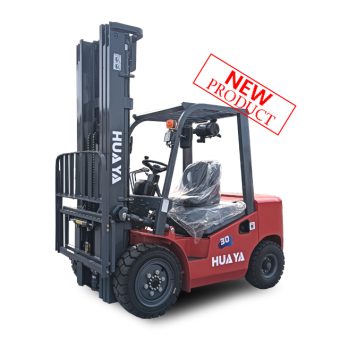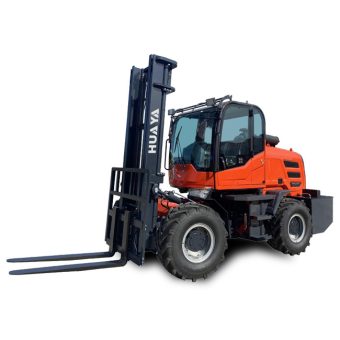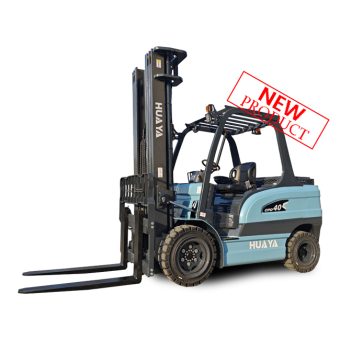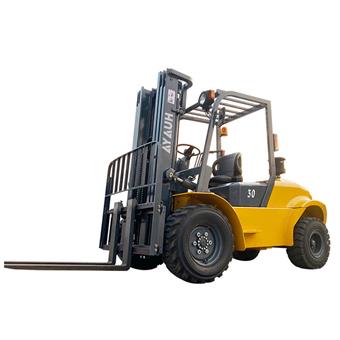
Notícias
Quando se trata de elevar e movimentar cargas pesadas, as empilhadeiras são as máquinas ideais para armazéns, canteiros de obras e instalações industriais. Mas nem todas as empilhadeiras são iguais, e entender as diferenças entre uma empilhadeira padrão e uma empilhadeira para terrenos acidentados pode lhe poupar tempo, dinheiro e frustração.

A empilhadeira clássica é como o sedã confiável do mundo do manuseio de materiais. Ela foi construída para ser eficiente em superfícies planas e estáveis, como pisos de armazéns, fábricas ou pátios de estocagem pavimentados. Eis o que faz com que ela se destaque:
As empilhadeiras padrão são compactas e manobráveis, o que as torna perfeitas para navegar em espaços apertados. Com uma distância do solo relativamente baixa, essas máquinas são excelentes em ambientes internos ou controlados, onde o terreno é previsível.
Os pneus de uma empilhadeira padrão geralmente são feitos de borracha sólida ou pneus de amortecimento. Eles oferecem excelente tração em superfícies lisas, mas não são feitos para lidar com terrenos acidentados ou irregulares.
Embora versáteis em muitos cenários, as empilhadeiras padrão geralmente têm capacidades de elevação menores em comparação com suas contrapartes para terrenos acidentados. Elas são ideais para mover paletes, caixas e materiais dentro de armazéns ou em caminhões de entrega.
Se a empilhadeira padrão é o sedã, a empilhadeira para terrenos acidentados é o SUV robusto. Ela foi projetada para enfrentar ambientes externos desafiadores, desde canteiros de obras enlameados até campos rochosos. Veja por que ela é um divisor de águas para o trabalho externo:
Essas empilhadeiras são construídas de forma robusta, com estruturas reforçadas e maior distância do solo. Isso permite que elas atravessem terrenos irregulares e acidentados com facilidade.
Equipadas com pneus pneumáticos ou cheios de espuma, as empilhadeiras para terrenos acidentados podem aderir a superfícies soltas, como terra, cascalho ou areia. O tamanho maior dos pneus e a construção robusta também contribuem para uma condução mais suave.
A maioria das empilhadeiras para terrenos acidentados é movida por motores a diesel, o que lhes dá a força necessária para transportar cargas mais pesadas por longas distâncias. Elas também são equipadas para lidar com condições climáticas extremas.
A segurança é uma prioridade quando se trabalha em terrenos irregulares. As empilhadeiras para terrenos acidentados geralmente apresentam estabilizadores ou sistemas de tração nas quatro rodas para manter as operações seguras e estáveis.
Vamos colocá-los lado a lado para uma rápida comparação:
| Recurso | Empilhadeira padrão | Empilhadeira para terrenos acidentados |
| Terreno | Superfícies lisas e planas | Terrenos irregulares e acidentados |
| Pneus | Pneus maciços ou com amortecedor | Pneus pneumáticos ou cheios de espuma |
| Fonte de energia | Elétrico ou a gás | Diesel |
| Distância do solo | Baixa | Alta |
| Uso típico | Manuseio de materiais em ambientes internos | Construção ao ar livre, agricultura |
Sua escolha depende inteiramente do trabalho em questão. Se seu trabalho gira em torno de tarefas internas, corredores estreitos e ambientes controlados, a empilhadeira padrão será sua melhor aposta. Por outro lado, se você estiver enfrentando elementos externos, terrenos acidentados e cargas pesadas, a empilhadeira para terrenos acidentados será o seu herói.
Entender a diferença entre esses dois tipos de empilhadeiras é fundamental para a eficiência e a segurança no trabalho. A máquina certa não só economizará seu tempo e esforço, mas também reduzirá o desgaste do seu equipamento. Não importa se você está levantando paletes em um armazém ou navegando em um canteiro de obras lamacento, há uma empilhadeira perfeitamente adequada às suas necessidades.



